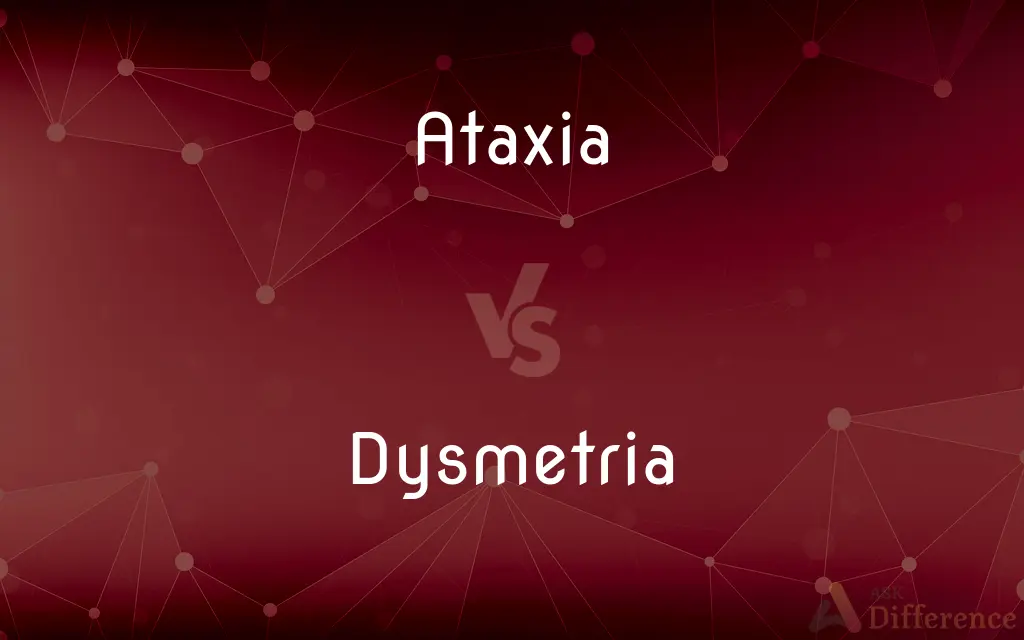Ataxia vs. Dysmetria — What's the Difference?
By Fiza Rafique & Urooj Arif — Updated on March 19, 2024
Ataxia is a neurological sign characterized by a lack of voluntary coordination of muscle movements; dysmetria, however, specifically refers to a type of ataxia where there is an inability to judge distance or scale.

Difference Between Ataxia and Dysmetria
Table of Contents
ADVERTISEMENT
Key Differences
Ataxia encompasses a variety of coordination problems, including difficulties with speech, eye movements, and swallowing, stemming from damage to different parts of the nervous system. Dysmetria is a specific manifestation of ataxia that affects a person's ability to control the range of movement necessary to meet a target, often observed as overshooting (hypermetria) or undershooting (hypometria) when reaching for objects.
While ataxia can be a symptom of many conditions, such as stroke, multiple sclerosis, or genetic diseases, dysmetria is primarily associated with lesions in the cerebellum, the part of the brain responsible for coordinating movement. Patients with dysmetria typically have cerebellar ataxia, indicating that their coordination issues are due to problems in this specific brain region.
The diagnosis of ataxia involves a comprehensive neurological examination and possibly imaging studies to identify the underlying cause, whereas diagnosing dysmetria might include tests that specifically assess the ability to estimate distances, such as asking a patient to touch their nose or reach for an object with their eyes closed.
Treatment for ataxia focuses on addressing the root cause, if known, and may include medications, physical therapy, or surgery. For dysmetria, therapy often emphasizes exercises that improve coordination and accuracy of movements, sometimes incorporating visual cues to help compensate for the impaired distance estimation.
Comparison Chart
Definition
Lack of voluntary coordination of muscle movements.
Inability to judge distance or scale in movements.
ADVERTISEMENT
Manifestations
Can affect speech, eye movements, swallowing.
Specifically involves overshooting or undershooting targets.
Associated Conditions
Stroke, multiple sclerosis, genetic disorders.
Often related to cerebellar lesions.
Diagnostic Focus
Broad neurological examination and imaging studies.
Tests assessing ability to estimate distances.
Treatment
Addresses underlying cause; may include physical therapy.
Focuses on improving coordination and accuracy.
Compare with Definitions
Ataxia
Symptoms include unsteady walk, fine motor task difficulties, and slurred speech.
Her ataxia led to difficulties in writing.
Dysmetria
Often results from damage to the cerebellum.
His dysmetria was diagnosed after an MRI showed cerebellum lesions.
Ataxia
Can result from damage to the brain, spinal cord, or nerves.
Cerebellar ataxia affects movements due to cerebellum damage.
Dysmetria
Leads to overshooting (hypermetria) or undershooting (hypometria) targets.
When trying to touch his nose, he consistently missed, indicating dysmetria.
Ataxia
A neurological condition marked by impaired balance and coordination.
After the stroke, he developed ataxia, making it hard to walk.
Dysmetria
Treatment involves exercises to improve movement accuracy.
Occupational therapy helped her compensate for dysmetria.
Ataxia
Treatment aims to improve symptoms and underlying causes.
He underwent physical therapy to manage his ataxia.
Dysmetria
A form of ataxia where there's an inability to control the distance, power, and speed of an action.
Dysmetria made it challenging for her to reach objects without overshooting.
Ataxia
Not a specific disease, but a sign of various underlying conditions.
Genetic testing revealed her ataxia was due to a hereditary disorder.
Dysmetria
Assessed through specific coordination tests.
The finger-to-nose test is commonly used to diagnose dysmetria.
Ataxia
Ataxia is a neurological sign consisting of lack of voluntary coordination of muscle movements that can include gait abnormality, speech changes, and abnormalities in eye movements. Ataxia is a clinical manifestation indicating dysfunction of the parts of the nervous system that coordinate movement, such as the cerebellum.
Dysmetria
Dysmetria (English: wrong length) is a lack of coordination of movement typified by the undershoot or overshoot of intended position with the hand, arm, leg, or eye. It is a type of ataxia.
Ataxia
The loss of full control of bodily movements.
Dysmetria
An inability to control or to limit muscular movement.
Ataxia
Loss of the ability to coordinate muscular movement.
Ataxia
Any of various degenerative, often hereditary, disorders that are characterized by ataxia and are frequently associated with cerebellar atrophy.
Ataxia
(pathology) Lack of coordination while performing voluntary movements, which may appear to be clumsiness, inaccuracy, or instability.
Ataxia
(chemistry) The condition of a polymer in which the orientation of the subunits is random
Ataxia
(obsolete) Disorder; irregularity.
Ataxia
Disorder; irregularity.
Ataxia
Irregularity in disease, or in the functions.
Ataxia
Loss of coordination in the voluntary muscles, especially the limbs; an inability to coordinate voluntary muscle movements; it results in unsteady movements and a staggering gait. See also locomotor ataxia, an ataxia which occurs when attempting to perform coordinated muscular movements.
Ataxia
Inability to coordinate voluntary muscle movements; unsteady movements and staggering gait
Common Curiosities
What causes ataxia?
Ataxia can be caused by brain damage, genetic disorders, stroke, or other neurological conditions.
Can dysmetria occur without ataxia?
Dysmetria is a form of ataxia, so it does not occur independently but as a manifestation of ataxia.
Are there treatments that specifically target dysmetria?
Treatment focuses on improving coordination and movement accuracy, often through physical or occupational therapy.
How does cerebellar damage lead to dysmetria?
The cerebellum coordinates movement precision and timing; damage disrupts this, causing dysmetria.
How are children with ataxia or dysmetria treated?
Treatment usually involves tailored physical and occupational therapy to improve motor skills.
How is dysmetria diagnosed?
Through neurological exams that test the ability to control movement distance, such as the finger-to-nose test.
Can dysmetria worsen over time?
It can if the underlying cause progresses, emphasizing the importance of monitoring and therapy.
What is the main difference between ataxia and dysmetria?
Ataxia is a broad term for coordination problems, while dysmetria is a specific type of ataxia related to estimating movement range.
Can ataxia and dysmetria be cured?
While some forms can be managed or improved, many are chronic conditions that require ongoing therapy.
What role does genetics play in ataxia?
Some ataxias are hereditary, caused by genetic mutations affecting the nervous system.
How do doctors decide on the best treatment for ataxia or dysmetria?
Treatment decisions are based on the underlying cause, severity, and individual patient needs.
Is dysmetria a sign of multiple sclerosis?
Yes, it can be, as multiple sclerosis can affect the cerebellum and cause coordination issues.
Can lifestyle changes help manage ataxia or dysmetria?
While they can't cure these conditions, physical activity and therapy can improve symptoms.
Is there a difference in how ataxia and dysmetria affect daily life?
Both can significantly impact daily activities, but dysmetria specifically makes tasks requiring precise movements challenging.
Are there any new treatments for ataxia or dysmetria?
Research is ongoing, with some advances in genetic therapies and medication for specific types.
Share Your Discovery

Previous Comparison
Doujinshi vs. Manga
Next Comparison
Smash vs. HitAuthor Spotlight
Written by
Fiza RafiqueFiza Rafique is a skilled content writer at AskDifference.com, where she meticulously refines and enhances written pieces. Drawing from her vast editorial expertise, Fiza ensures clarity, accuracy, and precision in every article. Passionate about language, she continually seeks to elevate the quality of content for readers worldwide.
Co-written by
Urooj ArifUrooj is a skilled content writer at Ask Difference, known for her exceptional ability to simplify complex topics into engaging and informative content. With a passion for research and a flair for clear, concise writing, she consistently delivers articles that resonate with our diverse audience.













































